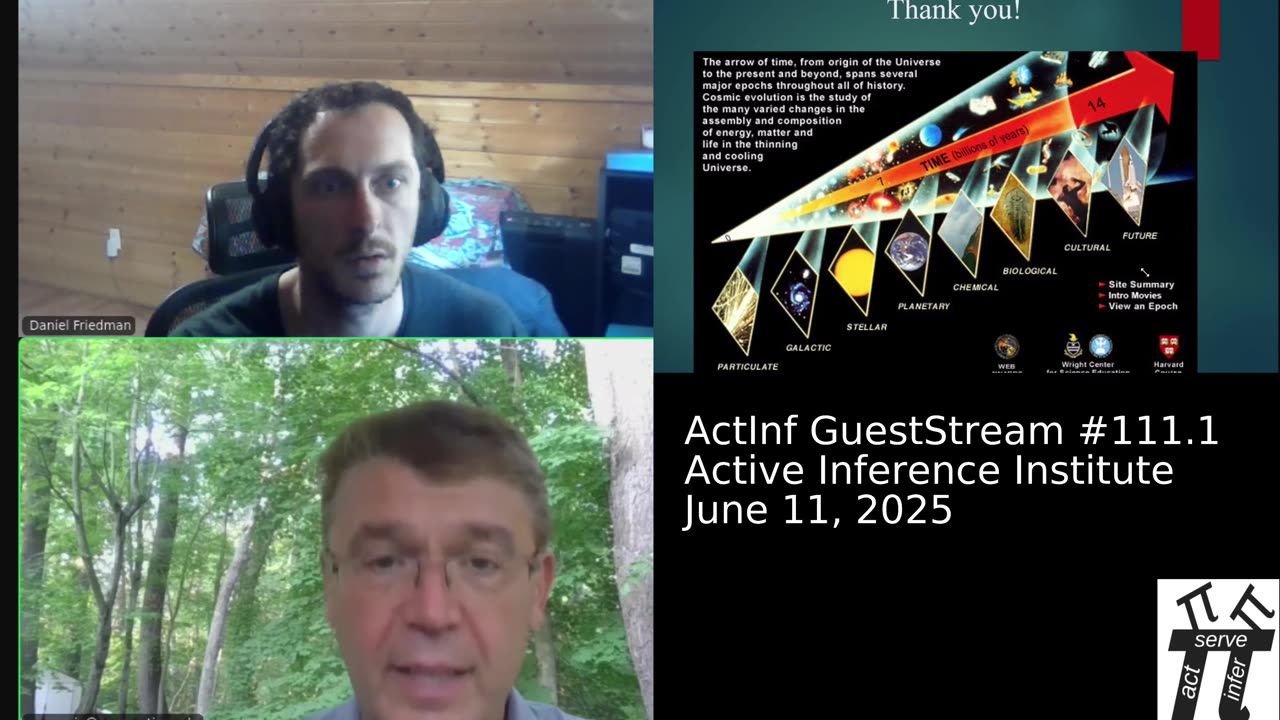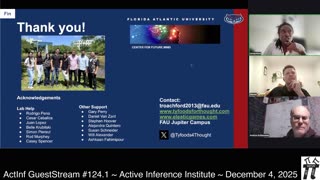Premium Only Content

ActInf GuestStream 111.1 ~ Modeling and Predicting Self-Organization in Dynamic Systems (G Georgiev)
Modeling and Predicting Self-Organization in Dynamic Systems out of Thermodynamic Equilibrium: Part 1: Attractor, Mechanism and Power Law Scaling
https://www.mdpi.com/2227-9717/12/12/2937
by Matthew Brouillet, and Georgi Yordanov Georgiev
Abstract:
Self-organization in complex systems is a process associated with reduced internal entropy and the emergence of structures that may enable the system to function more effectively and robustly in its environment and in a more competitive way with other states of the system or with other systems. This phenomenon typically occurs in the presence of energy gradients, facilitating energy transfer and entropy production. As a dynamic process, self-organization is best studied using dynamic measures and principles. The principles of minimizing unit action, entropy, and information while maximizing their total values are proposed as some of the dynamic variational principles guiding self-organization. The least action principle (LAP) is the proposed driver for self-organization; however, it cannot operate in isolation; it requires the mechanism of feedback loops with the rest of the system’s characteristics to drive the process. Average action efficiency (AAE) is introduced as a potential quantitative measure of self-organization, reflecting the system’s efficiency as the ratio of events to total action per unit of time. Positive feedback loops link AAE to other system characteristics, potentially explaining power–law relationships, quantity–AAE transitions, and exponential growth patterns observed in complex systems. To explore this framework, we apply it to agent-based simulations of ants navigating between two locations on a 2D grid. The principles align with observed self-organization dynamics, and the results and comparisons with real-world data appear to support the model. By analyzing AAE, this study seeks to address fundamental questions about the nature of self-organization and system organization, such as “Why and how do complex systems self-organize? What is organization and how organized is a system?”. We present AAE for the discussed simulation and whenever no external forces act on the system. Given so many specific cases in nature, the method will need to be adapted to reflect their specific interactions. These findings suggest that the proposed models offer a useful perspective for understanding and potentially improving the design of complex systems.
Active Inference Institute information:
Website: https://www.activeinference.institute/
Activities: https://activities.activeinference.institute/
Discord: https://discord.activeinference.institute/
Donate: http://donate.activeinference.institute/
YouTube: https://www.youtube.com/c/ActiveInference/
X: https://x.com/InferenceActive
Active Inference Livestreams: https://video.activeinference.institute/
-
 1:36:33
1:36:33
Active Inference Institute
11 days agoActInf GuestStream 124.1 ~ Ty Roachford: "PCT vs. FEP: A Comparison"
10 -
 LIVE
LIVE
Barry Cunningham
58 minutes agoLIVE BREAKING NEWS: President Trump Addresses The Nation! And More News!
2,062 watching -
 LIVE
LIVE
Laura Loomer
1 hour agoEP162: LIVE: President Trump Addresses The Nation
2,041 watching -
 LIVE
LIVE
The White House
1 hour agoPresident Trump Delivers an Address to the Nation
781 watching -
 LIVE
LIVE
Drew Hernandez
18 hours agoTRUMP ADDRESSES THE NATION & BONGINO ANNOUNCES FBI DEPARTURE?
645 watching -
 LIVE
LIVE
Badlands Media
12 hours agoBadlands Media Special Coverage - MY FELLOW AMERICANS the Alpha Warrior Show & Redpill Project
2,532 watching -
 22:54
22:54
Jasmin Laine
7 hours agoMedia MELTS DOWN as Poilievre Surges—Ottawa Loses Control of the Narrative
7158 -
 59:50
59:50
BonginoReport
4 hours agoDan Bongino Is Leaving The FBI - Nightly Scroll w/ Hayley Caronia (Ep.199)
229K178 -
 1:14:51
1:14:51
Kim Iversen
5 hours agoSTILL SHADY: Candace Meets With Erika — She Was Right
136K173 -
 1:04:57
1:04:57
Candace Owens
5 hours agoBREAKING NEWS! We Received Photos Of Charlie's Car After The Assassination. | Candace Ep 281
119K327